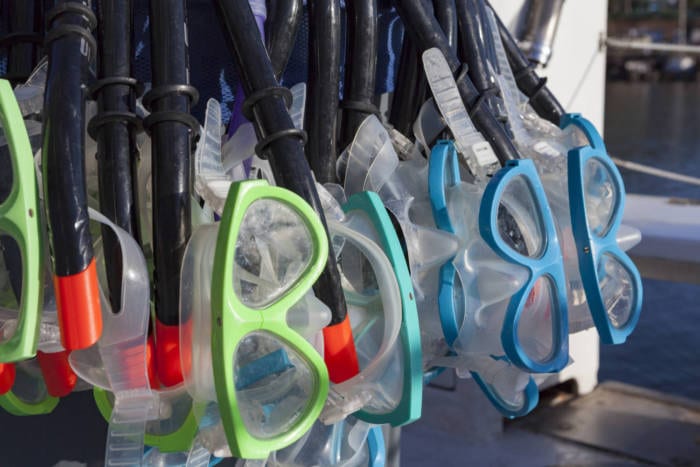Beginners Guide to Snorkeling
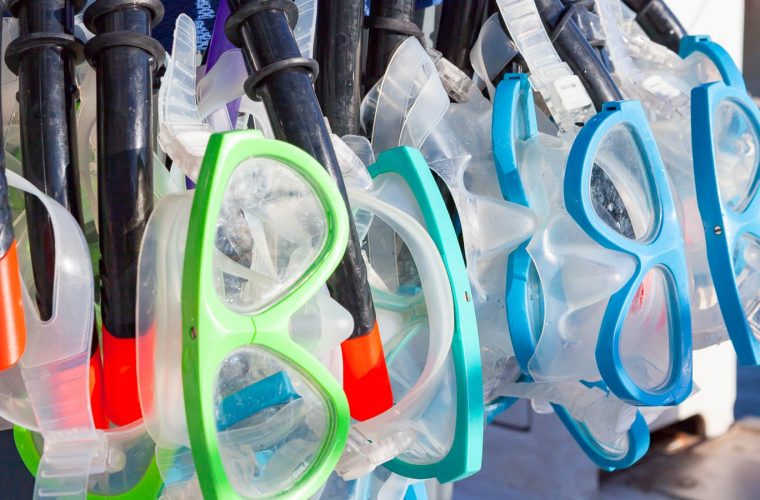
What Is Snorkeling?
Snorkeling is defined as “swimming along the surface of the water while using specific equipment that allows you to view the underwater world”. While snorkeling, you will be equipped with a mask, a snorkel (breathing tube), flippers, and a flotation belt (optional). Previous swimming experience is encouraged, however, not necessary if you can calmly float on the waters surface using a flotation belt. Snorkeling does not require any specific training or much physical effort. Our Maui snorkel tours on the Four Winds II and the Maui Magic provide a snorkel 101 class on board before getting in the water.
Diving Mask
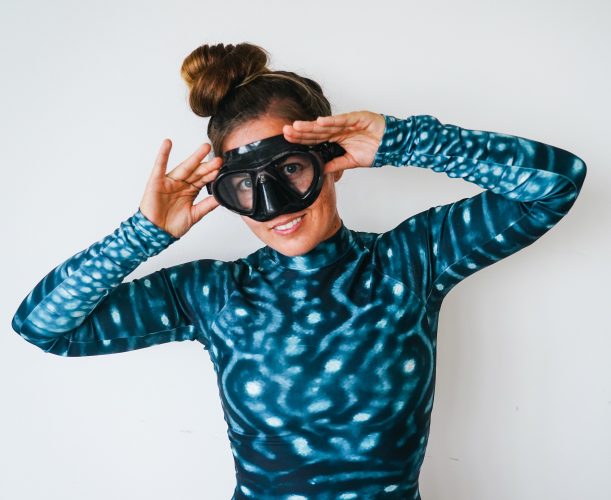 A diving mask is a piece of equipment that allows divers and snorkelers to see clearly underwater. Since the mask has an air space in front of the eyes, it allows divers and snorkelers to view everything underwater normally and clearly. For those who uses glasses or contacts, you can use a corrective lens mask. On the Four Winds II and the Maui Magic, we have prescription masks that go up to -7.
A diving mask is a piece of equipment that allows divers and snorkelers to see clearly underwater. Since the mask has an air space in front of the eyes, it allows divers and snorkelers to view everything underwater normally and clearly. For those who uses glasses or contacts, you can use a corrective lens mask. On the Four Winds II and the Maui Magic, we have prescription masks that go up to -7.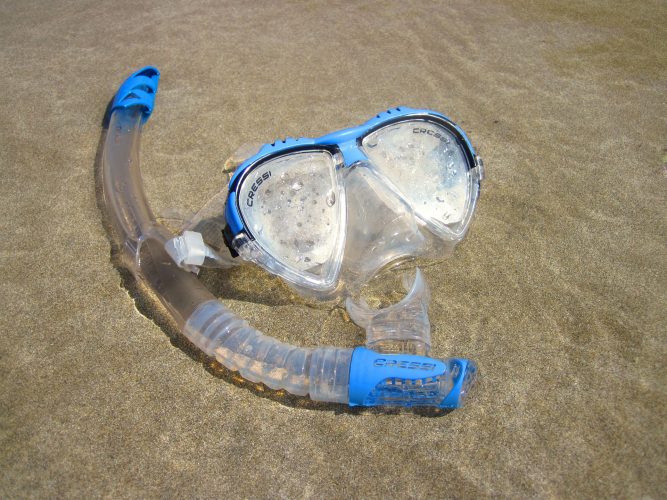 Snorkel
Snorkel
A snorkel is a device that allows one to breathe while having their face downward in the water, while the mouth and nose are submerged. A snorkel is an extremely helpful piece of equipment.
A snorkel allows you to partially submerge your head under water and breathe at the same time, while allowing air flow from above the waters surface. Snorkels are typically bent in a “L” or “J” shape with a mouthpiece located at the lower end. The mouthpiece is usually constructed of rubber and plastic. Located on the mask is a clip, which allows you to connect the snorkel to the mask and and reduces the chance of loosing your snorkel in the water.
While you are snorkeling, it is very possible that some water may make its way into the snorkel tube. To clear the snorkel is simple; forcefully blow out air through your mouth to push the water out.
Swim Fins
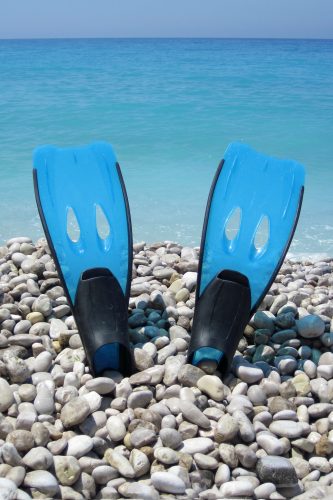 Fins play a very important role in snorkeling. Fins should light, flexible, and should fit snug. Loose fins can rub and often cause blistering on the heel. Since Maui has warm water, we don’t have to worry about keeping your feet warm, which is why we recommend using fins with less layers. We recommend using full foot fins with an open toe (this is what we use on our vessels). The Four Winds II and the Maui Magic have fins in every size. While on your way to Molokini Crater (or whichever snorkel location you go to), our crew members will go around and ask your shoe size and provide you with the proper sized fins.
Fins play a very important role in snorkeling. Fins should light, flexible, and should fit snug. Loose fins can rub and often cause blistering on the heel. Since Maui has warm water, we don’t have to worry about keeping your feet warm, which is why we recommend using fins with less layers. We recommend using full foot fins with an open toe (this is what we use on our vessels). The Four Winds II and the Maui Magic have fins in every size. While on your way to Molokini Crater (or whichever snorkel location you go to), our crew members will go around and ask your shoe size and provide you with the proper sized fins.Safety First!
As our Holiday season is upon us, the number of Visitors to the islands is up …. welcome, everyone!!! When joining a snorkel tour from a boat, the Captain and Crew are there to watch out for you and ensure your safety but the beaches and shorelines are another matter entirely.
The Hawaiian waters are very inviting and it is easy to forget how powerful the forces of nature can be, especially when on the beaches.
By following a few simple guidelines, you can make the most of our tropical paradise!
– NEVER, EVER turn your back to the ocean.
– Always swim with a buddy and do not count on flotation devices to keep you safe.
– Avoid murky waters. The greater your visibility, the better.
– Many Maui beaches have Lifeguards. If you are not an experienced beach-goer, it is generally best to stick with these spots.
– Talk to the Lifeguards and find out what the conditions are and ask about about conditions (surf, hidden rocks, strong currents, etc.).
– Always check to see if the rocks or sand you are walking on are dry and avoid wet areas. A shore break or large wave on the rocks can knock you off your feet quickly.
– Watch the water and the other beach-goers for a short while before entering the waters; 15-20 minutes.
– Pay close attention to all warning signs and heed them. These are put in place for your safety.
– Do not stand on the Coral Reefs … not only because these are living organisms, they can also be very sharp. When swimming or snorkeling, please enjoy looking at Hawaiian coral species but avoid stepping on or removing pieces of it. There is serious risk of cuts and infections by touching or stepping on it.
– Heed the “Golden Rule” … “When in Doubt, Don’t go out!”
The ocean is a majestic and powerful thing that must be respected. Following these tips will help ensure your Hawaii vacation will be safe and fun for the entire family!
THE 411 ON SNORKELING
Tips for Snorkeling in Maui
- Always know your limits. If you are new to snorkeling, it’s best to practice with the equipment in a pool to get used to it.
- Listen to life guards, hotel employees, boat crew, people that know our Maui waters. If it doesn’t look safe, it isn’t. If you don’t feel comfortable getting in, don’t go. If there are waves that you have to fight through to get to the reef, go another day when it is flat.
- If possible, apply your reef-safe sunscreen 30 min before getting in the water. This allows time for it to soak in.
- Always snorkel with a partner and use the “buddy system”. Be aware of your surroundings.
- Flotation is always a good idea if you are unsure, it will help you have extra buoyancy in the water. Float belts, boogie boards, noodles, life jackets are all good options
- Use de-fog on your to keep the fogging up. (We use baby shampoo and water on the Four Winds Snorkel Trips)
- Put your mask on before entering the water, but wait to put your fins on either on the swim steps on a boat, or in shallow water. You don’t ever want to walk with your fins on, they are for water, not land!
- Snorkel masks should cover your eyes and nose, make sure the mask strap is high up on the back of your head.
- Hair should be clear from the mask. If you have facial hair, use Vaseline to push it down under your nose to keep a good seal on your face.
- Make sure the straps are easily adjustable and all of the clips are secure.
- The bite tabs on the snorkel should fit comfortably in your mouth.
- Check the purge valve (if you have one at the end of the snorkel) to make sure it’s free of sand.
- The snorkel fins should fit comfortably. Too tight can cause cramps in your feet and legs, too loose and they will fall off.
- If you get cold easily, wearing a wetsuit will help maximize your time in the water.
- Look, but please don’t touch the marine life. The delicate eco-system can be damaged by kicking, touching or re-moving anything. Leave everything for the next snorkeler to enjoy.
- Stay within a safe distance from your entry point into the water, whether it’s from land or a boat.
- Practice slow and steading breathing. A relaxed snorkeler will have a better experience in the water. Know your limits, and pace yourself.
- Always stay safe and do not “over-do” it. We want your Maui snorkeling experience to be fun, not exhausting.
- Remember to look up every once in awhile to gage how far you have to swim back.
- Have fun and stay safe!!
